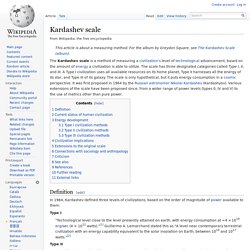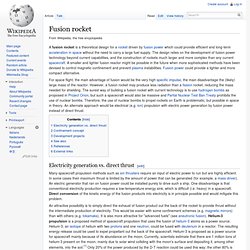

Kardashev scale. The Kardashev scale is a method of measuring a civilization's level of technological advancement, based on the amount of energy a civilization is able to utilize.

The scale has three designated categories called Type I, II, and III. A Type I civilization uses all available resources on its home planet, Type II harnesses all the energy of its star, and Type III of its galaxy. The scale is only hypothetical, but it puts energy consumption in a cosmic perspective. It was first proposed in 1964 by the Russian astronomer Nikolai Kardashev (Kardashyov). Various extensions of the scale have been proposed since, from a wider range of power levels (types 0, IV and V) to the use of metrics other than pure power.
Definition[edit] Type I "Technological level close to the level presently attained on earth, with energy consumption at ≈4×1019 erg/sec (4 × 1012 watts) Type II Type III "A civilization in possession of energy on the scale of its own galaxy, with energy consumption at ≈4×1044 erg/sec. Fusion rocket. Electricity generation vs. direct thrust[edit] Many spacecraft propulsion methods such as ion thrusters require an input of electric power to run but are highly efficient.

In some cases their maximum thrust is limited by the amount of power that can be generated (for example, a mass driver). An electric generator that ran on fusion power could be installed purely to drive such a ship. One disadvantage is that conventional electricity production requires a low-temperature energy sink, which is difficult (i.e. heavy) in a spacecraft. Direct conversion of the kinetic energy of the fusion products into electricity is in principle possible and would mitigate this problem. An attractive possibility is to simply direct the exhaust of fusion product out the back of the rocket to provide thrust without the intermediate production of electricity. Confinement concept[edit] To sustain a fusion reaction, the plasma must be confined. Development projects[edit] See also[edit] References[edit] Naturalistic science fiction.
From Battlestar Wiki, the free, open content Battlestar Galactica encyclopedia and episode guide Ron Moore's Essay on NSF Battlestar Galactica: Naturalistic Science Fiction or Taking the Opera out of Space Opera Our goal is nothing less than the reinvention of the science fiction television series.

We take as a given the idea that the traditional space opera, with its stock characters, techno-double-talk, bumpy-headed aliens, thespian histrionics, and empty heroics has run its course and a new approach is required. That approach is to introduce realism into what has heretofore been an aggressively unrealistic genre. Call it "Naturalistic Science Fiction. " This idea, the presentation of a fantastical situation in naturalistic terms, will permeate every aspect of our series: Visual. This shift in tone and look cannot be overemphasized. Perhaps nowhere will this be more surprising than in our visual effects shots. Editorial. Story. Science. And finally, Character. They are you and me. Hard science fiction. Today, the term "soft science fiction" is often used to refer to science fiction stories which lack a scientific focus or rigorous adherence to known science.

The categorization "hard science fiction" represents a position on a broad continuum--ranging from "softer" to "harder".[7] Scientific rigor[edit] The heart of the "hard SF" designation is the relationship of the science content and attitude to the rest of the narrative, and (for some readers, at least) the "hardness" or rigor of the science itself.[8] One requirement for hard SF is procedural or intentional: a story should try to be accurate, logical, credible and rigorous in its use of current scientific and technical knowledge about which technology, phenomena, scenarios and situations that are practically and/or theoretically possible, and later discoveries do not necessarily invalidate the label. For example, P. Schuyler Miller called Arthur C. Representative works[edit] Arranged chronologically by publication year. Novels[edit]